How to shape cucumbers?
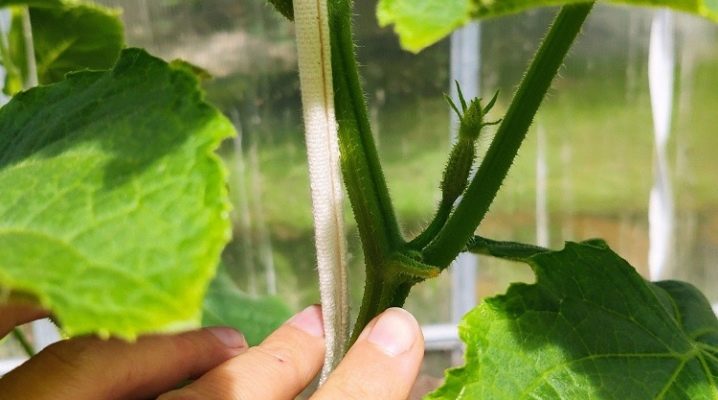
The correct formation of bushes is one of the key agricultural techniques when growing cucumbers. It allows you to set a certain direction for the growth of vines, which helps the plant to direct maximum energy to the harvest, and not to the development of green mass. That is why it is important to know when and how cucumbers should be shaped. The choice of a specific method for decorating a cucumber bush depends primarily on the varietal characteristics of the plant.
It is worth noting that there are general principles for carrying out such procedures, but there are certain nuances characteristic of bee-pollinated, parthenocarpic and hybrid species.

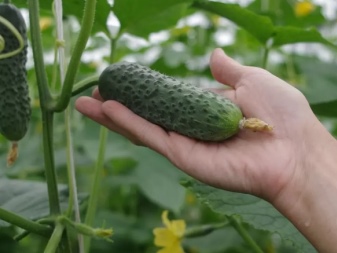
The need for a procedure
If you learn to carry out all the procedures correctly and in a timely manner, then you can count on a large harvest from each individual lash due to the formation of cucumber bushes. But it is important to take into account that the formation of this vegetable crop in the beds, that is, in the open field, and in greenhouses, are different processes that have significant differences. But in any case, it is important to remember that plants that develop by themselves, without human intervention, will sooner or later turn into real bush thickets. In such jungles, formed both in the garden and in the greenhouse, it is very difficult to carry out processing and garter, as well as to harvest.
The problem under consideration is the most urgent, when seedlings of branched varieties are selected for cultivation of cucumbers. Excessively elongated and at the same time thin lashes of plants will be less illuminated and ventilated, which in itself can provoke the development of many diseases. If you do not break off certain first ovaries and leave all shoots on the bushes, without exception, then the yield, as a rule, is significantly reduced. In such situations, fruits will not be able to form both on the main (central) trunk and on the side branches. In parallel, the ovaries may begin to turn yellow, dry actively and eventually fall off.
Competent formation of a cucumber bush contributes to:
- concentration of all the forces of culture on fruiting;
- significant improvement in light access and its even distribution;
- rational use of areas when growing vegetables in greenhouses;
- a noticeable increase in the term of fruiting;
- multiple facilitation of all the manipulations within the framework of planting care and harvesting as it ripens.
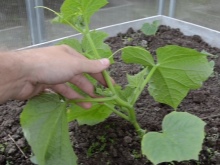
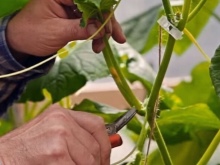

It is worth noting that even if one of the formation stages was missed, then it is imperative to eliminate weak shoots that thicken the bushes. Inexperienced gardeners who are afraid of injuring the plants are advised to pinch their stepchildren with ovaries during growth. The implementation of the described agrotechnical technique does not provide for accurate measurements of the length of shoots using a ruler and calculating the number of nodes. It is important to remember that the current and actively used schemes for the formation of cucumbers are conditional, since in each specific case it is necessary to take into account the peculiarities of the garden or greenhouse, as well as the varietal properties and forms of plantings.
By the way, the formation of the bushes has both supporters and opponents. According to the latter, the vegetable culture in question is capable of developing and bearing fruit well on its own.And it is worth noting that such statements are true, especially when it comes to growing bee-pollinated varieties in the open field. But here it is important to remember that seedlings in the garden are placed at fairly large intervals, which will provide enough light and nutrients for all plants. Otherwise, the stems will inevitably intertwine, and the fruits on the ground will rot.
As long-term practice shows, it is much more convenient and more rational to grow cucumbers using trellises and using the formation of bushes. This is most relevant for greenhouses, which most often have to deal with limited space. At the same time, now more and more often you can find varieties of vegetables that do not need the described procedures. We are talking, in particular, about such hybrids as:
- Sarovskiy;
- "Bouquet";
- Valdai;
- Izhorets;
- "Pace".
The listed types of cucumbers do not need human intervention. This is due to the presence of a rather powerful central stem against the background of short and poorly developing lateral shoots.
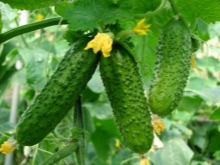
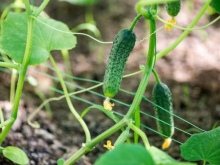
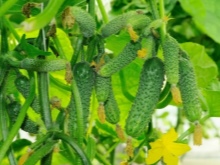
Fundamental rules
At the moment, you can easily find step-by-step instructions in which the entire process of forming a cucumber bush will be described in detail so that in the end there are few lashes. The choice of a particular method depends on the cultivar and plant conditions. It is clear that when growing vegetables on a windowsill, in greenhouses and in beds, the approach to formation will be different. However, there are general rules.
- All the necessary operations aimed at the formation of bushes must be carried out on time.
- In order to ensure full air access to the roots and prevent the competition of plants for light and nutrition, thickening of the bottom should not be allowed.
- The central stem should point straight up.
- The formation of dense thickets along the trellis structure is unacceptable.
- Shrub formation work is best done in the morning so that the wounds can dry out and heal during daylight hours.
- Barren flowers, as well as dry or diseased shoots and leaves, must be cut and broken off daily, without leaving hemp.
- An exceptionally sharp, properly sharpened and disinfected tool is used for trimming. Tearing off the lashes often leads to serious damage and often death of the plant.
- During pinching, the tip of the shoots is removed directly so as not to cause irreparable damage to the bush.
- It is highly recommended to turn the whips as little as possible, as cucumbers can react painfully to this.
- One of the key points is proper watering. It is impossible to water cucumbers over the leaves, since in this case only spraying is allowed. The temperature of the water used varies from 22 to 24 degrees. It is highly undesirable to water the heated soil with cold water.
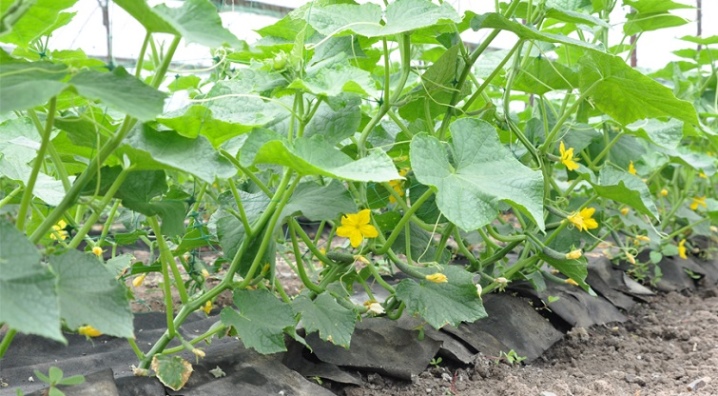
It is important to remember that at all stages of growth and development of a vegetable crop, it is necessary, in parallel with the formation of bushes, to promptly remove dried and affected leaves, tendrils and shoots that have already borne fruit.
Special attention should be paid to the moment associated with pruning the leaves of cucumbers. It is no secret that it is in them that photosynthesis is carried out, which is necessary for the ovaries and ripening of fruits. In the context of formation, it is necessary to use the rule according to which each ovary must necessarily have a leaf that is responsible for feeding the greens.
Based on the foregoing, it is allowed to remove the already mentioned defective leaves, as well as leaves that thicken the planting and prevent its normal ventilation. First of all, the foliage is cut off at the very bottom, that is, lying on the ground. After they move on to removing the side shoots, on which the cucumber crop was previously harvested. This approach allows you to create the most comfortable microclimate for plants in plantings. It is important to remember that the leaves are cut off without leaving petioles.
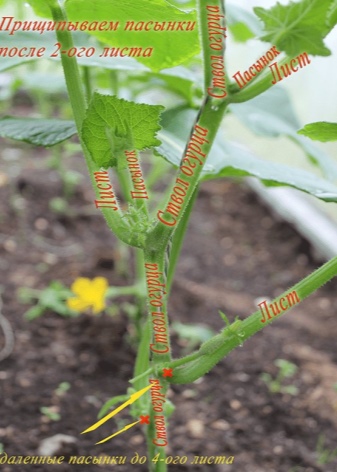

Formation of different varieties
At the moment, farmers use different methods of formation, the choice of which is determined by several key factors. At the same time, it is worth considering the classic version of the described agrotechnical method aimed at increasing the yield of a popular vegetable crop. It is relevant both for modern bee-pollinated species and for parthenocarpic hybrids.
It is important to note that the universal method is suitable for plants in which female flowers form both on the central stem and on the lateral shoots. If, in the process of growth, it turned out that there are no ovaries at the level of 6 or 7 leaves, and exclusively male flowers are formed, then you can remove the main stem, leaving a pair of the strongest lateral ones. They are fixed on the trellis and the growth points are removed after the 5th sheet. Another key point is that it is unacceptable to cut off the male flowers, which are necessary for pollination and the formation of ovaries.
Bushes of slightly branched hybrid varieties with a bouquet type of flowering are formed, as a rule, according to the so-called umbrella principle. As already noted, the working scheme is chosen taking into account the place of growing vegetables. So, this method involves the construction of two trellises in the upper part of the greenhouse. The main thing is that pruning and pinching is done in the morning using a sharp and processed tool.
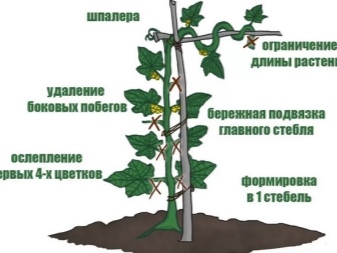
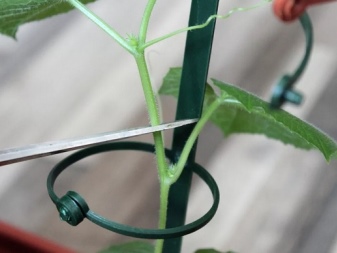
Parthenocarpic and hybrids
Initially, it is worth noting that modern hybrid varieties differ in that they have almost 100% female flowers. It turns out that the ovaries of such cucumbers are formed on the main stem. Often, in such species, several embryos can form in each leaf axil. But it should be remembered that only about 1/5 of them will eventually become full-fledged fruits. The rest in the process of growth of the bush will dry out and disappear. That is why it is imperative to form hybrids and parthenocarpic varieties of cucumbers.
Bushes of hybrids are most often formed into one stem, taking into account the following important points.
- Plants are tied to a horizontally oriented trellis in any convenient way. This is done about 12-15 days after planting the cucumbers in the ground.
- The tops of the lashes should remain free and be able to wrap around the tied twine as they grow.
- As soon as the main shoot reaches the top of the support structure, it must be tied up, and the top must be pinched or cut off.
- At the next stage, all lateral stems are removed, as well as antennae and flowers up to the third leaf from below.
- Shoots that grow after the indicated mark are pinched. It is important to note that the harvest in such cases is formed mainly on the main lash.
- If we are talking about long-fruited varieties of cucumbers, then after all the listed parts of the bush are removed up to the 3rd leaf, they pinch the central stem approximately on the 3-4 leaf line. The main thing is that before that he has grown to the top of the trellis.
The shoots formed later in the axils of these leaves will need to be thrown over the trellis and directed towards the garden bed. Then they are pinched a meter from the ground. The cucumbers themselves in such cases will be formed first on the main, and then on the growing stems.
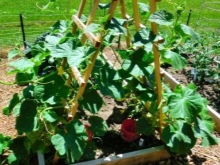
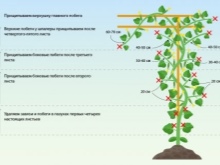
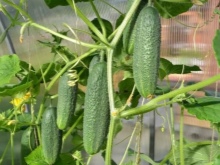
Beam
Nowadays, the popularity of varieties of cucumbers is actively growing, which have a bunch, that is, bouquet fruiting. In such species, 5 full-fledged fruits or more are formed in each sinus. As a rule, such bushes are formed into one lash. Their excessive thickening with lateral stems with an abundance of ovaries leads to depletion, therefore, to the inevitable loss of part and a significant deterioration in the quality of the crop. The algorithm of actions in the formation of a bunch of cucumber bush is as follows.
- At the initial stage, after removing the fruits, a full-scale pinching is carried out in the lower part of the bush.
- As soon as the main stem reaches the trellis, this lash is thrown over it. In this case, the stem is directed towards the ground and, as it grows, is cut off at a height of 20-30 cm from its surface.
With this formation of the cucumber bush, it is mainly the main whip that bears fruit. It is worth noting that gardeners also use another way to implement the considered agrotechnical measure.
- The side stems are removed to the level of the trellis.
- The central shoot is wrapped around the support structure and pinched.
- At the top, 1-2 stepsons are left, and then thrown over, after the second leaf with an ovary they are pinched and sent down.
Regardless of the method of forming bundled cucumbers, the so-called blinding of the lower sections of the stems should first be performed. This implies the removal of all, without exception, lateral shoots, flowers and antennae to the level of the 3rd leaf.
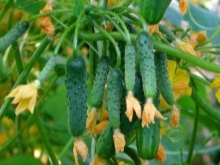
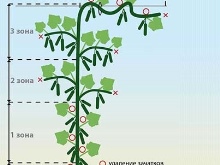
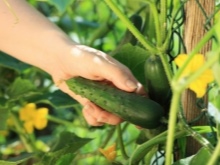
Indeterminate
In this case, we are talking about long-known traditional, as well as highly branched more modern varieties of the described culture. It is no secret that they actively bear fruit on the lateral stems. Based on this, such bushes are formed in several lashes.
- The central shoot is pinched off after 4-5 leaves.
- The two stepsons formed at the top are pulled out and directed in opposite directions.
- Shoots are fixed (tied up) and pinched.
- After throwing over, the left stems are cut about 1-1.5 meters from the ground.
As a result of such actions, the plant will begin to bush evenly in two directions. This, in turn, will contribute to the emergence and full development of a large number of quality cucumbers.
There is also an alternative course of action. Plucking the top of the main stem, that is, that part of it where most barren flowers are formed, allows you to achieve the maximum number of lateral shoots. This is what, with proper care, will be the guarantee of a future bountiful harvest. Here it is important to shorten all new stems after 2-4 leaves, taking into account the thickening of the planting, as well as the degree of lighting.
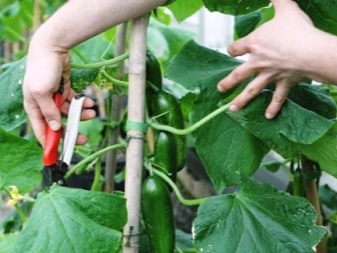
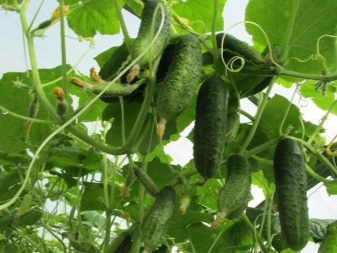
Nuances of carrying out taking into account the place of cultivation
As already noted, the choice of one or another method of formation is influenced by the location and conditions in which cucumbers are grown. So, if we are talking about greenhouses, then the main task will be to prevent the growth of lashes. A dense jungle with its leaves will block the fruits from sunlight, as well as hide them from bees and take away nutrients in parallel. At the same time, when growing crops in the beds, they try to make the bushes thicker in order to protect the crop from temperature fluctuations.
Taking into account such features, abundantly branching varieties are often planted in open ground. The formation of bushes in such situations has a number of important features. When constructing support structures, the areas used for cucumbers, as well as the convenience of processing plants and harvesting, are taken into account.
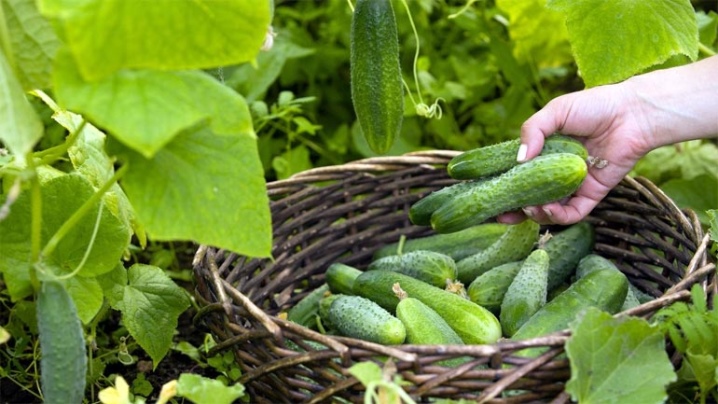
In the open field
If we compare the varieties most suitable for greenhouse conditions and open beds, then in the second case, preference is given to cucumbers, which are characterized by abundant shoot formation. Here, the thicker the cucumber jungle, the richer and better fruiting. It is unlikely that on such beds it will be possible to see a whip in splendid isolation. When forming such bushes, it is recommended to consider the following most important points.
- Pinching is usually not used.
- Flowers of both sexes appear simultaneously and in comparable quantities on all stems.
- The fruits form and develop evenly throughout the bush.
- The creation of a microclimate is directly and directly proportional to the number of shoots.
- In dense cucumber thickets, carbon dioxide is released, which is so necessary for the full growth and development of this vegetable crop.
- Long and branched shoots are able to effectively protect fruits from difficult weather conditions, as well as direct sunlight, which can cause irreparable damage to the crop.
However, when growing cucumbers outdoors, certain rules should be followed, taking into account the area of plant nutrition. We are talking, in particular, about varieties for which excessively long main shoots are characteristic, which are formed to the detriment of the formation of ovaries. Such specimens are usually shortened after 6-8 leaves. This leads to the germination of lateral shoots with full and strong ovaries. In other cases additional agrotechnical operations aimed at forming bushes will not be required.


In the greenhouse
In this case, the formation of bushes is of particular importance, since it allows you to create the most favorable conditions for the growth and development of plants, as well as increasing the yield. The key to success will be following certain simple rules. It is important to take into account the key features of growing crops in greenhouses.
- The nuances of the implementation of agricultural techniques will depend on whether varietal vegetables or hybrid ones are grown.
- In the situation with varietal specimens, female flowers appear predominantly on lateral stems. The main whip here serves as a platform for males (barren flowers).
- Premature pinching of the main trunk provokes the active development of the lateral processes. The result of this will inevitably be a thickening of the planting with the subsequent development of diseases and a deterioration in yield.

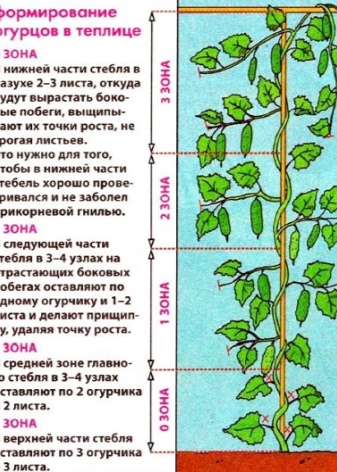
In the described conditions, the bushes are formed into one lash, on which the future harvest will be concentrated. The appropriate procedures are started 10-15 days after the transfer of seedlings to the ground. It will be important to remember the following rules.
- All units must be tied at a height of 100-150 mm.
- The trellis is made at least 1.5 m.
- Plants are tied up carefully, avoiding tension.
- Loops around the stalks of the young should not be overtightened so as not to damage them.
- You can wrap the shoots around the twine in any direction. It is important that the tip remains free.
The next stage is the removal of all leaves without exception, as well as ovaries and flowering up to the 4th true leaf. Cotyledons are not taken into account in this case. This procedure is called blinding.
It is worth noting that such measures have a beneficial effect on the development of plants and their productivity. The fact is that in the leaves of the lower row, a minimum of ovaries is most often formed, but at the same time they take away some of the nutrients.
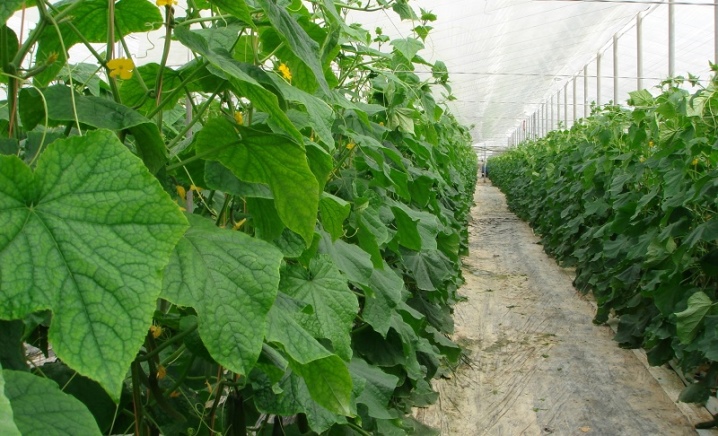













The comment was sent successfully.